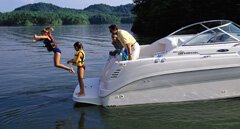At best, a fouled anchor is a nuisance. At worst, it can be the worst kind of dangerous. According to the official investigation into the tragic deaths of three football players in February, a fouled anchor was the first in a chain of events that resulted in the players’ boat capsizing in the Gulf of Mexico. By rigging a foul-free anchor, you’ll have a far easier time getting that hook safely off the bottom. Here are two methods:
1. The Floating Trip Line
Tie a 3/8-inch polypropylene line, its length greater than the water’s maximum depth, to the anchor’s tripping ring or crown eye. At the opposite end of the line, attach a small marker buoy. In the event of a snag, pull or carefully motor up to the float bow-first, taking in the anchor rode as you do. Pull upward on the trip line, or opposite the direction the anchor has dug in. It should pull the anchor out crown first.
Disadvantage: The excess line in the water risks fouling your prop.
2. The Breaking Trip Line
Fasten the rode directly to the anchor’s crown or tripping ring. Run the chain along the shank, and secure it to the tip of the shank with two to three plastic zip ties 2a, or three to four turns of carpenter’s twine. Should the anchor become fouled, bring your boat over the anchor, taking up excess rode and cleating off to the anchor post or bow cleat. Motor slowly in the opposite direction you anchored and the tie should break 2b, shifting the direction of force and pulling the anchor out by its crown.
Disadvantage: Overnighters might worry about breaking a zip tie should the weather turn nasty.
Be Safe, Not Sorry
Accidents happen fast, and when they do, those aboard have little time to react. Should you encounter trouble freeing an anchor off the bottom, heed experts’ advice to keep your boat and crew safe.
Never Tie Off The Anchor To The Stern
With less buoyancy, a lower freeboard and the weight of an engine, the stern is already vulnerable to flooding, especially on a smaller boat. Add in an anchor rode to foul the prop, and you’ve got a recipe for disaster.
Provide A Position To The Coast Guard
If you’re having serious trouble pulling up the anchor, don life jackets, call the Coast Guard and provide a position. You can always call back and advise them if you break it free.
Realize When To Cut And Run
Anchors might be expensive, but they’re not worth losing your boat, or your life. If conditions deteriorate or water threatens to flood the stern, always be ready - and willing - to cut the line and run.
Shared with permission by Boating Magazine.


